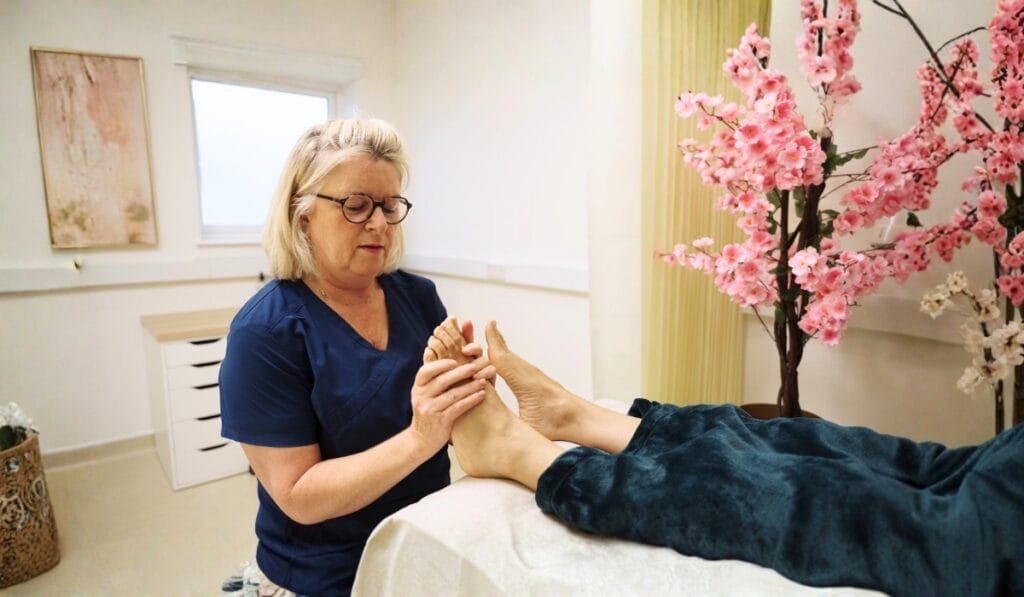Treatment options and pricing
Browse and click below to book any of our available service.
Reflexology for Cancer Initial Appointment
Included in the Reflexology for Cancer Initial Appointment
During the initial reflexology session for cancer, we review your medical history, treatment plan, and current symptoms. A personalised foot or hand therapy is then provided to help reduce fatigue, ease pain, lower stress, and improve overall comfort and wellbeing.
Reflexology for Cancer Follow-up Appointment
Included in the Reflexology for Cancer Follow-up Appointment
Follow-up reflexology sessions for cancer assess your progress, symptoms, and energy levels. Each session is tailored to continue easing fatigue, reducing pain, lowering stress, and supporting overall comfort and well-being throughout your treatment or recovery.
Common Q&A about Reflexology for Cancer
Our FAQ section is designed to address common questions you may have, from how our treatments work to what you can expect during and after your session.
Our team is always available to provide additional support if you need more personalised guidance, ensuring that you feel informed and confident every step of the way.
Yes. Reflexology can be safely used throughout treatment, with modifications to pressure, session length, and timing to avoid treatment days [9].
Many people benefit from weekly or fortnightly sessions, then reduce frequency as symptoms improve or treatment ends [5].
No. Reflexology is non-invasive and does not affect medications or cancer therapies. It complements medical treatment by helping you relax and cope better [9].
Yes. Research shows improvements in sleep quality, anxiety reduction, and emotional balance after regular sessions [3,4,5].
Yes. Several studies demonstrate a reduction in treatment-related fatigue and increased feelings of vitality [1,2].
No. The pressure is light and soothing. Some tender spots may be felt briefly as your body responds, but overall, it should feel deeply relaxing.
Yes. Evidence suggests that reflexology may reduce tingling, numbness, and discomfort caused by chemotherapy-induced peripheral neuropathy [8].
We delay or adapt treatment if you have open wounds, active infection, severe neuropathy, DVT, or very low platelets. Your safety is our first priority.
Some people feel calmer immediately; others notice improvement after 2–3 sessions. Benefits are often cumulative, building over time.
Yes. Reflexology forms part of The Health Suite’s Integrative Oncology Programme, which includes nutritional therapy, stress management, GP support, and advanced wellness services for patients during and after cancer.
Research and Evidence
- Najafpour Z, et al. (2023). Effect of Reflexology in Treating Cancer Pain: Meta-Analysis. Pain Management Nursing, 24(2): 79–87.
- Kang J, et al. (2023). Reflexology and Cancer-Related Fatigue: Systematic Review. Complementary Therapies in Clinical Practice, 51: 101746.
- Bahrami M, et al. (2022). Effect of Reflexology on Sleep and Quality of Life in Cancer Patients. European Journal of Oncology Nursing, 58: 102147.
- Tian EJ, et al. (2023). Effectiveness of Reflexology on Mental Health in Cancer. Frontiers in Psychology, 14: 1163025.
- Klaus M, et al. (2024). Reflexology in Oncological Treatment – Systematic Review. Supportive Care in Cancer, 32(5): 2121–2133.
- Sharp D, et al. (2020). Complementary Therapies in Cancer Care: Reflexology and Quality of Life. European Journal of Integrative Medicine, 35: 101079.
- Wyatt G, et al. (2012). Reflexology for Lymphoedema Management in Breast Cancer Survivors. Oncology Nursing Forum, 39(6): 609–617.
- Jane SW, et al. (2021). Reflexology for Chemotherapy-Induced Peripheral Neuropathy: Pilot Study. Integrative Cancer Therapies, 20: 1–10.
- Cancer Research UK. (2024). Reflexology (Complementary Therapy).
- Macmillan Cancer Support. (2023). Complementary Therapies and Cancer Care.



